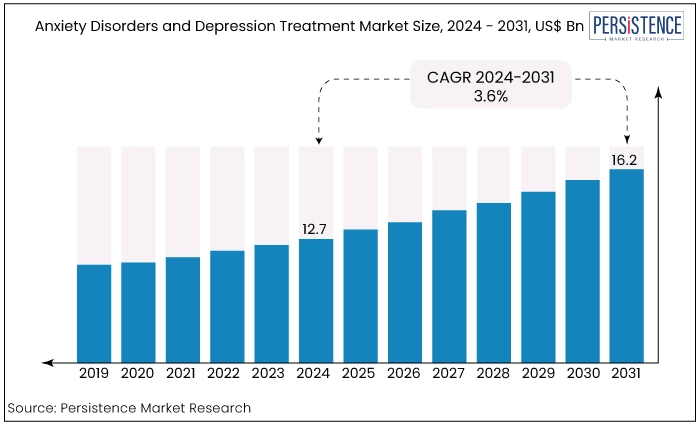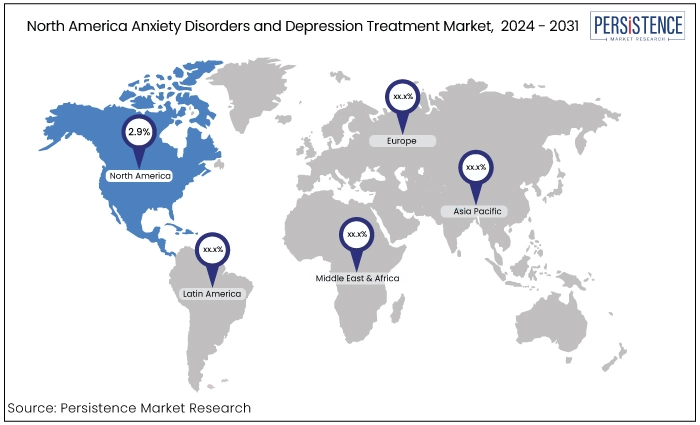Industry: Healthcare
Published Date: September-2024
Format: PPT*, PDF, EXCEL
Delivery Timelines: Contact Sales
Number of Pages: 182
Report ID: PMRREP34763
The global anxiety disorders and depression treatment market is estimated to be valued at US$16.2 Bn by the end of 2031 from US$12.7 Bn anticipated in 2024. The market is expected to secure a CAGR of 3.6% from 2024 to 2031. This market growth is attributed to several factors such as increasing awareness of mental health issues, advancements in treatment options, and a rise in the prevalence of these conditions.

Key Highlights of the Market
|
Market Attributes |
Key Insights |
|
Global Anxiety Disorders and Depression Treatment Market Size (2024E) |
US$12.7 Bn |
|
Projected Market Value (2031F) |
US$16.2 Bn |
|
Global Market Growth Rate (CAGR 2024 to 2031) |
3.6% |
|
Historical Market Growth Rate (CAGR 2019 to 2023) |
3.2% |
|
Region |
CAGR through 2031 |
|
North America |
2.9% |
North America holds a significant share in the market due to several interrelated factors. The region exhibits a high prevalence of these mental health conditions. According to the National Institute of Mental Health (NIMH), around 19.1% of adults in the U.S. experience anxiety disorders, while around 7.1% suffer from depression annually. This high prevalence creates a substantial demand for effective treatments, leading to significant market investment and growth.
North America benefits from advanced healthcare infrastructure, which supports the development and distribution of mental health treatments. The United States has a well-established healthcare system that facilitates the availability of new and advanced therapies.
The U.S. Food and Drug Administration (FDA) frequently approves new medications for anxiety and depression, reflecting the country’s commitment to addressing mental health challenges. In 2023 alone, the FDA approved several novel antidepressants and anxiolytics, showcasing ongoing innovation in the market.

Europe is expected to exhibit significant growth global anxiety disorders and depression treatment market due to several compelling factors. One of the key drivers is the increasing prevalence of mental health disorders across the continent.
According to the World Health Organization (WHO), nearly one in four Europeans will experience a mental health condition at some point in their lives. This rising prevalence is spurring greater demand for effective treatment options and driving market growth.
Europe is experiencing a rise in the number of research and development activities focused on mental health. The continent hosts several leading pharmaceutical companies and research institutions that are actively engaged in developing new treatments for anxiety and depression.
For instance, leading pharmaceutical companies like Novartis and AstraZeneca have ongoing research programs and collaborations aimed at discovering novel therapies for these conditions. This robust R&D environment is expected to drive growth in the treatment market.
|
Category |
Projected CAGR through 2031 |
|
Drug Class - Antidepressants |
3.2% |
Antidepressants remain the top-selling drug category due to their widespread use and efficacy in treating mood disorders like depression and anxiety, which affect millions globally. They offer significant relief for patients when other treatments fail.
Continued advancements in antidepressant formulations, such as newer SSRIs and SNRIs with fewer side effects, bolster their market dominance. Additionally, increased awareness and reduced stigma around mental health issues contribute to higher prescription rates.
The consistent demand and evolving therapeutic options ensure that antidepressants maintain their leading position in the pharmaceutical market.
|
Category |
Projected CAGR through 2031 |
|
Indication - Anxiety |
3.3% |
Anxiety is the leading indication in anxiety disorders and depression treatment due to its high prevalence and significant impact on daily functioning. Disorders like generalized anxiety disorder (GAD) and panic disorder affect millions driving the demand for effective treatments. The focus on anxiety reflects the need for interventions that address symptoms like excessive worry, fear, and stress, which can also co-occur with depression.
Advances in therapeutic options including medication and cognitive-behavioural therapy (CBT) aim to provide relief and improve quality of life underscoring the critical role of addressing anxiety in mental health care.
The anxiety disorders and depression treatment market focus on managing mental health conditions through medications, therapies, and emerging treatments. Driven by rising prevalence and increased awareness, it includes various drug classes and innovative therapies, with a growing emphasis on personalized and digital solutions to improve patient outcomes.
Additionally, several factors are anticipated to boost the market share, including the rising incidence of anxiety and depression, growing awareness, and new product launches by major market players.
For example, a September 2021 WHO report highlighted that depression affects about 3.8% of the global population, with 5.0% among adults and 5.7% in those over 60, totalling around 280 million people in 2021. Additionally, 2022 TRV data indicated that 264 million people worldwide had an anxiety disorder in 2021. This increasing prevalence is expected to drive market growth.
The approval of new products is also expected to fuel market expansion. In July 2021, Alembic Pharmaceuticals received final approval from the US FDA for its Abbreviated New Drug Application (ANDA) for Desipramine Hydrochloride tablets in various dosages. This product is deemed therapeutically equivalent to Norpramin Tablets, approved for treating depression.
From 2019 to 2023, the anxiety disorders and depression treatment market saw significant growth driven by increasing mental health awareness, novel drug developments, and expanded treatment options.
Advancements in medications, digital therapeutics, and improved diagnostics contributed to this upward trend. Looking ahead, from 2024 to 2031, the market is expected to continue expanding, fuelled by rising global prevalence of these conditions, ongoing innovations in treatment modalities, and increased healthcare investments.
The growth trajectory will likely be supported by new product launches, regulatory approvals, and a greater emphasis on personalized and digital health solutions.
Rising Awareness and Enhanced Diagnosis
Increased awareness and improved diagnosis have significantly impacted the demand for anxiety and depression treatments. Historically, mental health conditions were often under-recognized or misdiagnosed due to stigma, lack of knowledge, and insufficient training among healthcare providers.
As awareness of mental health issues has grown, so has the ability to accurately diagnose these conditions. Public health campaigns, educational programs, and media coverage have played crucial roles in increasing understanding and reducing stigma leading to more individuals recognizing symptoms in themselves and others. For example, initiatives like the National Alliance on Mental Illness (NAMI) and campaigns such as "Mental Health Awareness Month" have significantly contributed to this shift.
The impact of increased awareness is evident in statistics showing higher rates of diagnosis. According to the National Institute of Mental Health (NIMH), nearly 21% of adults in the U.S. experienced any mental illness in 2022, up from 19.1% in 2020.
The rise reflects not only an increase in actual prevalence but also better identification and reporting. For instance, in a study conducted by the World Health Organization (WHO) in 2023, around 280 million individuals globally experience depression. This includes 5% of the adult population worldwide and 5.7% of adults aged 60 and older.
High Drug Dosages for Neurological Damage
High doses of drugs used to treat damaged neurological cells often end up harming healthy cells as well, leading to a range of negative side effects such as weight gain, vision problems, nausea, and dizziness. These adverse effects from anxiety and depression medications are negatively impacting the demand for therapy.
The lack of available resources further hampers market growth. For example, WHO research indicates that between 44% and 70% of patients in developed countries do not receive treatment, with the disparity being even more pronounced in developing countries, where it approaches 90%.
Anxiety and Depression Treatment through Digital and Personalized Innovations
Future opportunities for companies in the anxiety disorders and depression treatment market are vast, driven by advancements in technology and personalized medicine. One significant opportunity lies in the development of digital therapeutics and telehealth solutions.
With the increasing use of smartphones and wearable devices, companies can leverage digital platforms to offer remote therapy, real-time monitoring, and personalized treatment plans. This approach not only enhances patient accessibility and engagement but also provides valuable data for improving treatment efficacy. Companies that innovate in this space can capture a growing market segment that values convenience and technology-driven care.
With the potential in exploring novel treatment modalities and personalized approaches. Advances in genomics and biomarkers are paving the way for more tailored therapies that address the underlying biological mechanisms of anxiety and depression.
Companies investing in research to develop personalized medications and targeted therapies stand to benefit from reduced trial-and-error in treatment and improved patient outcomes.
The competitive landscape for the anxiety disorders and depression treatment market features major pharmaceutical companies, biotech firms, and emerging startups. Key players focus on developing advanced medications, digital therapies, and novel treatment modalities. Competition is driven by innovation, regulatory approvals, and strategic partnerships in the mental health sector.
Recent Industry Developments in the Market
|
Attributes |
Details |
|
Forecast Period |
2024 to 2031 |
|
Historical Data Available for |
2019 to 2023 |
|
Market Analysis |
US$ Billion for Value |
|
Key Regions Covered |
|
|
Key Market Segments Covered |
|
|
Key Companies Profiled in the Report |
|
|
Report Coverage |
|
|
Customization & Pricing |
Available upon request |
By Drug Class
By Indication
By Distribution Channel
By Region
To know more about delivery timeline for this report Contact Sales

High healthcare spending, and expanding digital health solutions are driving up demand for anxiety and depression treatments.
A few of the key players operating in the market are Pfizer Inc., H. Lundbeck A/S, and Glaxo SmithKline.
The market is estimated to be valued at US$12.7 Bn in 2024.
The antidepressants to lead the market exhibiting a CAGR of 3.2% through 2031.
North America is estimated to hold a CAGR of 2.9% through 2031.